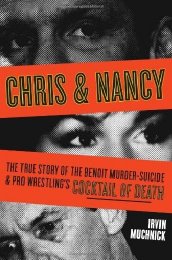The True Story of the Benoit Murder-Suicide and Pro Wrestling's Cocktail of Death
The beauty of professional wrestling is something that is very difficult to explain to someone who isn't a fan.
At its best, it can be a conglomeration of great athletics and story, tugging on the human heart strings like any great theatre drama. At its worst, it can be a parody of itself, insulting to the intelligence, with enough low-rent "humour" to make Jerry Springer blush.
The latter description is the one that has been most applicable throughout the 2000s, with the art of what made the quasi-sport one of early kingpins of television (with different products, on both sides of the Atlantic) either forgotten by the performers, or frowned upon by the promoters. But for me - and, indeed, virtually everyone who ever worked with him - one wrestler always stood out from the pack, always delivering wrestling at its finest, even when placed in unenviable storyline circumstances.
That wrestler's name was Chris Benoit.
If the name rings a bell, it's likely down to the fact that in June 2007, Benoit murdered both his wife Nancy, and his third child (the first with Nancy) Daniel, before killing himself. In what is a story too convoluted to tell here, the Canadian took an entire weekend to commit the crimes, his final act being to take his own life by hanging himself with his weightlifting pulley, in a manner carefully designed to cause himself the greatest physical anguish possible.
The full story of the Benoit murder-suicide, the reaction of his WWE (World Wrestling Entertainment, formerly World Wrestling Federation) employers, the police investigation, and much more is detailed in the book "Chris & Nancy: The True Story of the Benoit Murder-Suicide & Pro Wrestling's Cocktail of Death". The author is Irv Muchnick, himself a wrestling fan, and the nephew of one of the USA's greatest wrestling promoters, Sam Muchnick.
The book does a remarkable job of bringing together every bit of information about the case - including some new and disturbing occurrences - making what is an incredibly complex story comprehensible, even if it remains impossible to know what was going through Benoit's distorted mind when he committed his crimes.
In some sections not for the week of heart, we get to know the details of how the bodies were found (even seeing a frightening picture of Daniel's bedroom, though thankfully with the body removed), how Chris and Nancy originally fell in through a love television storyline, how Benoit's life had been shattered by the deaths of many of his wrestling compatriots, including his dearest friend Eddie Guerrero, and how WWE tried to use its power (and, allegedly, many thought-out lies) to skewer the truth.
All of the above, and several other topics including the case of the Wikipedia hacker (a wrestling fan edited Wikipedia to state that Nancy had died several hours before anyone but Benoit knew that to be the case) and how the police botched several aspects of the proceeding investigation are morbidly fascinating, and kept this reader glued to the page. It would not be correct to call the book "entertaining", in the common sense of the word, but to say the facts of the story are compelling would be an understatement.
Through no real fault of its own, the later chapters of the book cannot hold a candle to those that come before it. The later chapters deal with "mark doctor" (in basic terms, a doctor so allured by the celebrity of the wrestlers that he was willing to give them any drugs they requested, in whatever dosage they preferred) Phil Astin and his relevance to the case, as well as Congress' aborted consideration of looking into the numerous high-profile deaths in pro wrestling. These chapters are interesting, but can't hold a candle to the pure intrigue of the murder-suicide story itself.
If there are negatives to be said about the book - aside from the depressing nature of the story - one might be the relatively small amount of time dedicated to how Dave Meltzer (universally recognised as the premier reporter on behind-the-curtain topics in the wrestling industry) handled the story. Muchnick is critical of Meltzer for reporting wrestling as normal during the aftermath of the Benoit murders, even though Meltzer covered the story in his Wrestling Observer Newsletter more regularly and with more depth than anyone had prior to the release of this book.
The other small issue to be taken with the book is the constant plugs for additional material on the case being sold by Muchnick, which includes autopsy reports, audio of 911 calls, and full text and e-mail messages from Benoit, Nancy, and others. It's a small issue, and understandable from a freelance journalist point of view, though it does provoke questions about profiting from such a terrible news event.
In conclusion, "Chris & Nancy" is essential reading for anyone who knew the name Chris Benoit - the wrestler. Those intrigued by non-fiction crime stories will likely find this to be as fascinating as any other book in that genre.





















Your Opinions and Comments
Be the first to post a comment!